Valencia, freshly squeezed
21-31/08/06
Although tempted to spray-paint our backpacks and blend into Barcelona, we continued down the coast to Valencia, the new home-town of our good friend Karina. It sounds easy, but we managed to find ourselves stuck in Barcelona for four hours too long, as we missed three successive buses, despite being in the right bus station. But tardiness is not so unlike us, or Karina, who was four and a half hours late to pick us up.
Perhaps because of the late-ness, we felt we had to get up the next morning and do some serious sight-seeing.
Valencia (actually, its Valenthia) is a coastal city inhabited by about 800 000 people. It’s an old city that is only getting a face lift now, since the council realized tourists like clean, kept old cities.
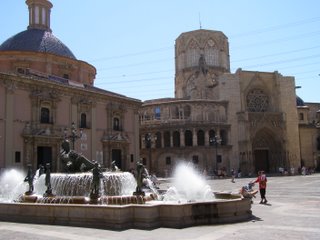
Karina showed us basilicas, cathedrals, cafes, paella dish shops, the silk exchange, the op shop, the grocery store, the famous festival sites and the unique graffiti.


Then she tested us to see if we had absorbed it all by linking it together with her favourite examples, such as her favourite fountain, which is behind the basilica, in view of the cathedral, which is one of the festival sites, but less frequented by tourists than the cafes, silk exchanges, etc…

By the end of the first day of sight-seeing, the three of us realized that sights were not the point of this trip. It had been almost one year since we had last seen Karina and we had come to Spain mostly to fix up that situation…and sights were not going to distract us.
From that day forth, we spent some great nights together drinking sangria and catching up.

We still went and saw the sights, like this awesome “City of Arts and Sciences”, built to keep Valenica on Spain’s cutting-edge-architecture bandwagon.
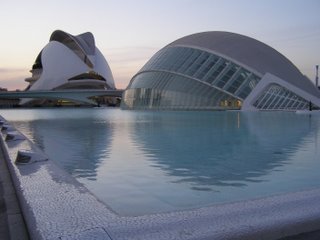

And we also tried to go and see a bullfight, but while we turned up at the place, time and day they set it for, no bulls did. It was a bit of a disappointment, but hardly a blow: we were a little hesitant to go anyway.

But we did it all at a leisurely pace, and between long stints at the beach in El Saler.


Thanks to some inside tips form our local guide, there were a few quirks about Valencia we started to notice.
First, while not exactly being in the middle of a rainforest (or any forest), nor being terribly natural at all, there is, in Valencia, a thriving colony of geckos, who cruise around the apartments with a gourmet’s eye for the best creepy-crawlies.

Also, while there’s usually a healthy flock of pigeons at most self-respecing places/placas/piazzas in Europe, in Valencia they’re a little unique. Rather than being mostly grey, Valencia’s birds are for the most part white doves, scurrying daintily in the dirt.

One thing that was introduced to us by Karina was the local arts scene. The graffiti was really interesting in both Barcelona and Valencia, but in Valencia there is one artist with whom the three of us shared a little fascination. Their work is everywhere in the district; throughout the city itself, and on many of the entrances and exits. Apparently it can even be seen in a few outlying villages. Although it is never signed, not even by an alias, the style is definitely recognizable, and has a recurring theme of…

…lemons. This symbol can be found on most dim streets and many main ones in the centre; usually on metal surfaces, and always colourful and enigmatic.

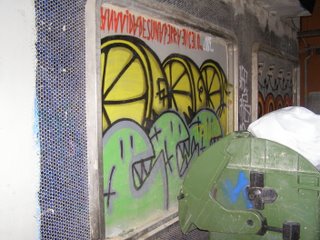
I guess the secret to the best sangria is a hint of lemon in with the oranges.
One thing we noticed during our travels through Valencia was the use of tiles. There’s a bit of Berber in the buildings, and everywhere there are little details that are decorated with 15cm square tiles, of blue and white. They colour corners,

border windows,

and cover the underside of the little balconies all the way to the top storey.

While it’s hardly a major part of the Valencia style, the blue and white tiles kept appearing the more we looked for them, like doing a sudoku puzzle.
While we were staying chez Karina we slept in her sunroom, 9 storeys up, with the Ayuntamiento (town hall) right in front of us. This gave us plenty of opportunities to get to know the ringing schedule intimately. There are five bells. At quarter past, they play the first 4 notes of a song. At half past, the first 8. At quarter to, the first 12, and on the hour, every hour, they play the whole 16-note song, with gusto, followed by the fifth bell counting the hours. Once we figured this out, we never needed a watch while in the city again.

One of our biggest collective concerns, and the most important consideration when it came to day-planning, was meal-times. We had become used to Spanish time (wake up at 10, lunch at 3, dinner at midnight, bed about 4) in terms of appetites, but found it harder to shake the habit of preparation times. Thus by lunch-time, we’d been mentally preparing it for 3 hours, and by dinner, about 4 hours. All this mental effort led to some serious meals being planned and executed. Food became such an important part of the holiday that Karina kept a special record of the dates and contents of our meals (athletes record great feats, we record great feasts). She made special notes about our banana pancakes,

the shepherds pie and strudel,

the mountain of scones, the vege pizza, the Roquefort pasta…we designed every meal like it was our last, and ate like it was our first in a long time. Of course this didn’t stop us trying out the local specialities, like paella (d’origine valencienne) and sangria,

and some great tapas,
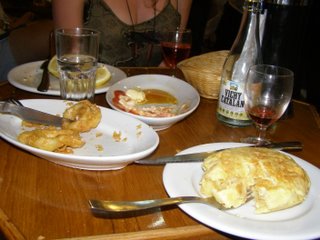
which inspired us to buy our own paella dish and promise to grow some of those olives with the red bits in (haven’t found one of those yet though).
We had the great fortune to be in the right place at the right time. Not only were we in time for la tomatina, but we were in town for a one night only free concert by the legendary flamenco singer, Carmen Linares. We lined up for an hour or so, surrounded by excited locals, and found ourselves squashed in front of a small stage. Accompanied by two guitarists and two foot-stampers, she sang some incredible songs, writhing with emotion, really dancing in her seat. While we couldn’t really understand any of the words, we could still follow the clutches and twists and grimaces. If we had any doubt, the olés from the crown set us straight: this was not pop.
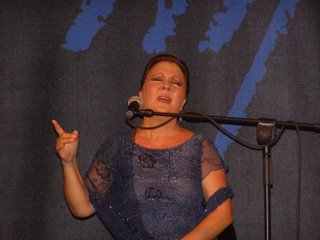

After the main event, they all came back for an encore, where the foot-stampers took to the stage to strut their stuff: singing, dancing, and improvising on the fly. It was really amazing, and while I didn’t learn much more Spanish, I damn well learned how to foot-stamp!


It was really great to go and see Karina, where she lived, and try to fatten her up for Autumn. It was a little surreal. After all, we were staying with a friend from Sydney, while on holiday from our new home, in her new home, all happening in Europe.
We had a lot of fun, really relaxed, and learned a whole lot of new things. But most important of all, we learned never to wear thongs or sandals to a Spanish harvest festival.
21-31/08/06
Although tempted to spray-paint our backpacks and blend into Barcelona, we continued down the coast to Valencia, the new home-town of our good friend Karina. It sounds easy, but we managed to find ourselves stuck in Barcelona for four hours too long, as we missed three successive buses, despite being in the right bus station. But tardiness is not so unlike us, or Karina, who was four and a half hours late to pick us up.
Perhaps because of the late-ness, we felt we had to get up the next morning and do some serious sight-seeing.
Valencia (actually, its Valenthia) is a coastal city inhabited by about 800 000 people. It’s an old city that is only getting a face lift now, since the council realized tourists like clean, kept old cities.

Karina showed us basilicas, cathedrals, cafes, paella dish shops, the silk exchange, the op shop, the grocery store, the famous festival sites and the unique graffiti.


Then she tested us to see if we had absorbed it all by linking it together with her favourite examples, such as her favourite fountain, which is behind the basilica, in view of the cathedral, which is one of the festival sites, but less frequented by tourists than the cafes, silk exchanges, etc…

By the end of the first day of sight-seeing, the three of us realized that sights were not the point of this trip. It had been almost one year since we had last seen Karina and we had come to Spain mostly to fix up that situation…and sights were not going to distract us.
From that day forth, we spent some great nights together drinking sangria and catching up.

We still went and saw the sights, like this awesome “City of Arts and Sciences”, built to keep Valenica on Spain’s cutting-edge-architecture bandwagon.


And we also tried to go and see a bullfight, but while we turned up at the place, time and day they set it for, no bulls did. It was a bit of a disappointment, but hardly a blow: we were a little hesitant to go anyway.

But we did it all at a leisurely pace, and between long stints at the beach in El Saler.


Thanks to some inside tips form our local guide, there were a few quirks about Valencia we started to notice.
First, while not exactly being in the middle of a rainforest (or any forest), nor being terribly natural at all, there is, in Valencia, a thriving colony of geckos, who cruise around the apartments with a gourmet’s eye for the best creepy-crawlies.

Also, while there’s usually a healthy flock of pigeons at most self-respecing places/placas/piazzas in Europe, in Valencia they’re a little unique. Rather than being mostly grey, Valencia’s birds are for the most part white doves, scurrying daintily in the dirt.

One thing that was introduced to us by Karina was the local arts scene. The graffiti was really interesting in both Barcelona and Valencia, but in Valencia there is one artist with whom the three of us shared a little fascination. Their work is everywhere in the district; throughout the city itself, and on many of the entrances and exits. Apparently it can even be seen in a few outlying villages. Although it is never signed, not even by an alias, the style is definitely recognizable, and has a recurring theme of…

…lemons. This symbol can be found on most dim streets and many main ones in the centre; usually on metal surfaces, and always colourful and enigmatic.


I guess the secret to the best sangria is a hint of lemon in with the oranges.
One thing we noticed during our travels through Valencia was the use of tiles. There’s a bit of Berber in the buildings, and everywhere there are little details that are decorated with 15cm square tiles, of blue and white. They colour corners,

border windows,

and cover the underside of the little balconies all the way to the top storey.

While it’s hardly a major part of the Valencia style, the blue and white tiles kept appearing the more we looked for them, like doing a sudoku puzzle.
While we were staying chez Karina we slept in her sunroom, 9 storeys up, with the Ayuntamiento (town hall) right in front of us. This gave us plenty of opportunities to get to know the ringing schedule intimately. There are five bells. At quarter past, they play the first 4 notes of a song. At half past, the first 8. At quarter to, the first 12, and on the hour, every hour, they play the whole 16-note song, with gusto, followed by the fifth bell counting the hours. Once we figured this out, we never needed a watch while in the city again.

One of our biggest collective concerns, and the most important consideration when it came to day-planning, was meal-times. We had become used to Spanish time (wake up at 10, lunch at 3, dinner at midnight, bed about 4) in terms of appetites, but found it harder to shake the habit of preparation times. Thus by lunch-time, we’d been mentally preparing it for 3 hours, and by dinner, about 4 hours. All this mental effort led to some serious meals being planned and executed. Food became such an important part of the holiday that Karina kept a special record of the dates and contents of our meals (athletes record great feats, we record great feasts). She made special notes about our banana pancakes,

the shepherds pie and strudel,

the mountain of scones, the vege pizza, the Roquefort pasta…we designed every meal like it was our last, and ate like it was our first in a long time. Of course this didn’t stop us trying out the local specialities, like paella (d’origine valencienne) and sangria,

and some great tapas,

which inspired us to buy our own paella dish and promise to grow some of those olives with the red bits in (haven’t found one of those yet though).
We had the great fortune to be in the right place at the right time. Not only were we in time for la tomatina, but we were in town for a one night only free concert by the legendary flamenco singer, Carmen Linares. We lined up for an hour or so, surrounded by excited locals, and found ourselves squashed in front of a small stage. Accompanied by two guitarists and two foot-stampers, she sang some incredible songs, writhing with emotion, really dancing in her seat. While we couldn’t really understand any of the words, we could still follow the clutches and twists and grimaces. If we had any doubt, the olés from the crown set us straight: this was not pop.


After the main event, they all came back for an encore, where the foot-stampers took to the stage to strut their stuff: singing, dancing, and improvising on the fly. It was really amazing, and while I didn’t learn much more Spanish, I damn well learned how to foot-stamp!


It was really great to go and see Karina, where she lived, and try to fatten her up for Autumn. It was a little surreal. After all, we were staying with a friend from Sydney, while on holiday from our new home, in her new home, all happening in Europe.
We had a lot of fun, really relaxed, and learned a whole lot of new things. But most important of all, we learned never to wear thongs or sandals to a Spanish harvest festival.

0 Comments:
Post a Comment
<< Home